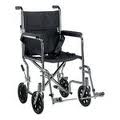Manual Wheelchair Choices
There are dozens of manual wheelchair styles to choose from. The capability of the user and the intended use will determine the best choice for you. The manual wheelchair is by far the most common. Are you looking for a wheel chair for Mom or Dad when you want to take them on a day trip? Many museums, parks and other recreational destinations will have them for borrowing or renting. If Mom or Dad are to the point where they often need a chair, a purchase is probably in order. Check with your doctor or therapist first and don't forget it may be covered by insurance.
On the otherhand, due to an accident, disease, or injury, a manual wheelchair may now become a permanent fixture in your life. Even though they are human powered, there are several advantages over an electric wheelchair. To name a few:
- Unlimited range.....no battery to keep charged
- Lighter weight....easier to push
- Easier to transport.....weighs less
- Lower Cost.....usually
- More mobile.....allows for easier physical activity
.....and familiarize yourself with the major wheelchair components:
Frame: There have been many changes in the framing material of a wheelchair making them more lightweight than ever. The material used directly affects the total weight of the chair and the overall strength. The most common material used is steel or aluminum. Titanium is very light but also very expensive. The two most common frame styles are “rigid” (meaning the frame remains in one piece), and folding (where the frame has a crossed brace beneath the seat for easy folding)
Upholstery: The upholstery is a place where you can let your personality shine!! The choices are almost endless. You can choose bright neon green or conservative black or canvas or synthetic fabrics or vinyl or leather and almost anything in between. Keep comfort in mind....you don’t want it to be too hot and it must withstand all kinds of weather and sturdy enough for daily use.
Seating system: Seating systems can be sold separately. Make sure they are compatible with each other. A choice here will be the back height...do you want shoulder height or mid back height? How wide should it be for you?
Brakes: While a manual wheelchair is in use, you stop by putting pressure on the wheel rims. There is also parking brakes to hold the chair in a locked position. Parking brakes are usually height adjustable and, for safety sake, should be set when rolling could be dangerous.
Wheels: The majority of wheelchairs have four wheels. Some specialty chairs (like racers) have only three. The rear wheels (except in transport chairs) are large, 20”-26”, (standard is 24”) and the standard tire is pneumatic (compressed air). Other types of tires are available, such as solid, semi-pneumatic, or radial tires for a higher cost. Solid tires reduce maintenance AND also comfort. Compare the comfort of each. Mag wheels and off road wheels are also an option. The small front wheels (casters) are six to eight inches in diameter and have the same choices in composition.
Footrests: Folding wheelchairs usually have detachable, swivel, height adjustable (flip up), heel rests, and/or leg rests that may or may not be padded. Most rigid frame manual wheelchairs have the footrests built into their frame.
Armrests: Again, more choices. Armrests come in a desk length which allows the user closer access to tables and desks. Also, full length is available. Both styles can usually be flipped up for easy side access or stationary (fixed) or removable. Armrests are helpful when balance could be an issue while getting in and out of a manual wheelchair. The more active user may like the "streamlined" look and choose an armless chair.
Once you have decided a manual wheelchair is the direction you want to follow, you then have to choose between a rigid frame and a folding wheelchair.
Rigid Lightweight Manual Wheelchair:

If you are active and have good upper body strength, this is the type of chair you will probably want. It gives you much more freedom for an active lifestyle that may even include sports. They are made to fit YOU. They are lightweight because of fewer moveable parts and also require less maintanance. It's footrests are usually part of the frame and may not have any armrests or push handles. Many weigh as little as 15 pounds. The lighter the weight, the better the efficiency. To allow more responsiveness, some wheels may have the ability to tip towards the user. The rear wheels can be easily removed and the back folds down so the user can place the chair in the back seat.
Standard Folding Manual Wheelchair:

Most of us, when we visualize a wheelchair, this style is what comes to mind. They are characterized by a cross-brace frame under the seat that allows them to be folded for easy storage. Push handles, detachable footrests and tipping levers are companion conveniences that adds to its weight. They can easily be folded and stored in the trunk of a car. The user probably has less upper body strength and must depend on a companion to push them for longer distances. Most weigh less than 40 pounds and carry a user that weighs up to 250 pounds. The heavy-duty models can hold up to 600 pounds.
Transport Wheelchair:

If you would like to leave all of the driving to someone else, a transport chair or sometimes called a companion chair, is for you. They are lightweight, foldable, and have four small wheels. A transport chair is most often used by individuals who do not normally need or use a wheelchair....ideal for those who use a cane or walker.
Further information on manual wheelchairs can be found in the following articles.
Return from Manual Wheelchair to Mobility Chair or Wheelchair Selection Basics
Return from Manual Wheelchair to Handicapped Mobility Aids